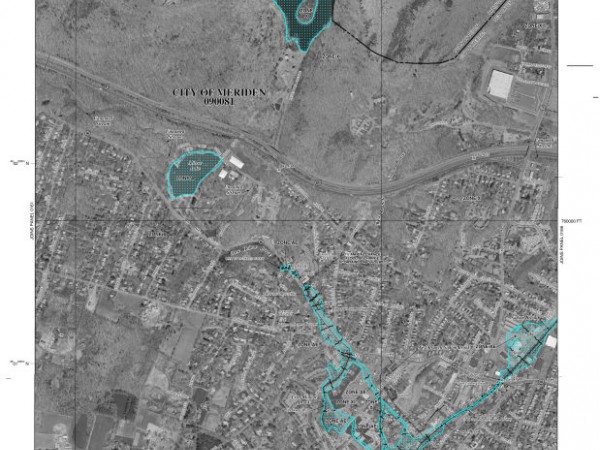
Wave-related splash over along the Connecticut shoreline requires smaller-scale resolution modeling. The FVCOM modeled data only displays storm surge while FEMA maps incorporate both surge and waves.The FVCOM model has higher accuracy in predicting storm surge levels.The modeled data is calibrated for Long Island Sound to capture the complexity of Connecticut’s geology and landscapes and improve accuracy for effective flood risk design.It is important to note that the 100 year flood event layer in this tool is different from FEMA’s 100 year flood map boundary for a few reasons: The vertical datum for all the datasets is NAVD88. The anticipated sea level of 20 inches by 2050 is also added to these different flood events using the same data described in the paragraph above (2016 LiDAR topographic data). The return period of the storm events is presented as 10, 30, 100, and 500 year flood events or 10%, 3.33%, 1%, and 0.2% annual exceedance probability storms, respectively. The floodwater elevation for the different return periods is calculated empirically using a Poisson-GPD fit. This model is calibrated for Long Island Sound to capture the complexity of Connecticut’s geology and landscapes and improve accuracy for effective flood risk design. The second set of data, is the modeled storm surge water levels using coupled coastal circulation and wave model (FVCOM-SWAVE, finite-volume coastal ocean model with the version of the Simulating Wave Nearshore) to hindcast the 44 highest storms between 1950-2018. These low-lying areas need further evaluation due to the hydrologic complexity created by flood control structures, bridges, and culverts. High probability areas of inundation are color shaded blue as well as low-lying areas, which are all shaded yellow. The Mean Higher High Water (MHWW) and 1 foot and 20 inches sea level rise layers are the modeled tidal water surface that has been created using VDatum (NOAA) and 2016 LiDAR topographic data. Two different sets of data are presented in the viewer.
#Flood zone map connecticut full
View Map Full Screen Data Description and Usage Click here to learn more about the FEMA Region 1 Viewer. The LiMWA line in this CIRCA viewer was updated in December 2021 to reflect FEMA’s LiMWA Viewer release for New England states, including Connecticut. Any area seaward of the red LiMWA line is either coastal AE or VE zone and must meet new construction requirements outlined in the updated state building code. The coastal AE Zone is depicted on current effective flood insurance rate maps (FIRMs) with the landward limit of the zone labeled “Limit of Moderate Wave Action”. Different projections of sea-level rise/storm surge scenarios will activate automatically at different scales.įEMA’s Limit of Moderate Wave Action (LIMWA) boundary is also shown on this viewer as a continuous red line. Use the Layers menu widget at the bottom of the map window to select data to display. To view the data, zoom in on the map to your area of interest. 7, which was introduced into the 2018 legislative session and was enacted into law as Public Act 18-82. CIRCA’s report on Connecticut sea level rise provided the basis for projections in Bill S.B. CIRCA research recommends that planning anticipates sea level will be 20 inches higher than the national tidal datum in Long Island Sound by 2050. © 2020 FloodMap.This dataset shows different flood maps with sea-level rise projections (1 foot and 20 inches), above the North American Vertical Datum of 1988 (NAVD88) along the Connecticut coastline and the adjacent inland.

#Flood zone map connecticut free
Notes:Before using this Flood Map application, please note that for various technical or non technical reasons the application is not guaranteed free of bugs or inaccuracies. Negative elevation means depth below sea level.ĭata Sources: Mazpzen, TNM, SRTM, GMTED, ETOPO1 The elevation layered on the map is in meters and is from sea level.



Branford, US Flood Map may help to provide flood alert/flood warning if flood water level at certain point is rising.Branford, US Flood Map may be useful to some extent for flood risk assessment or in flood management, flood control etc.


 0 kommentar(er)
0 kommentar(er)
